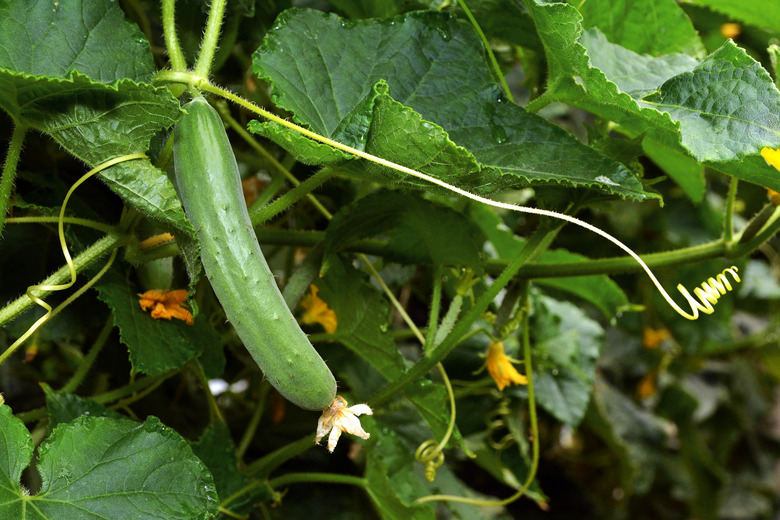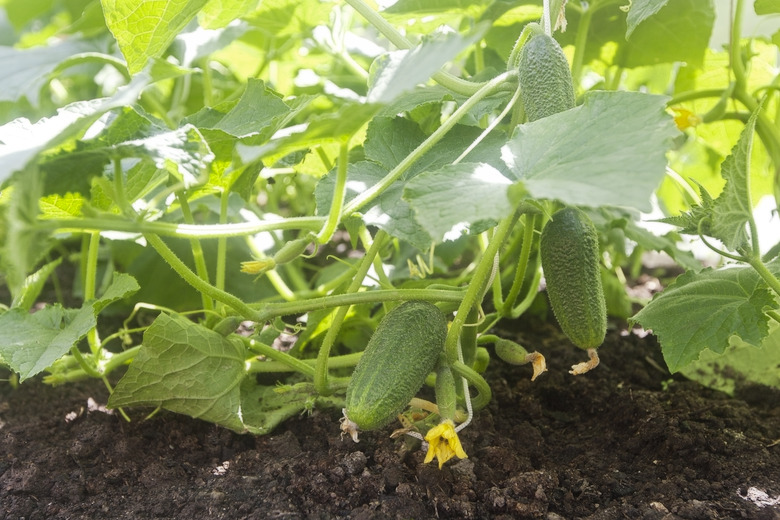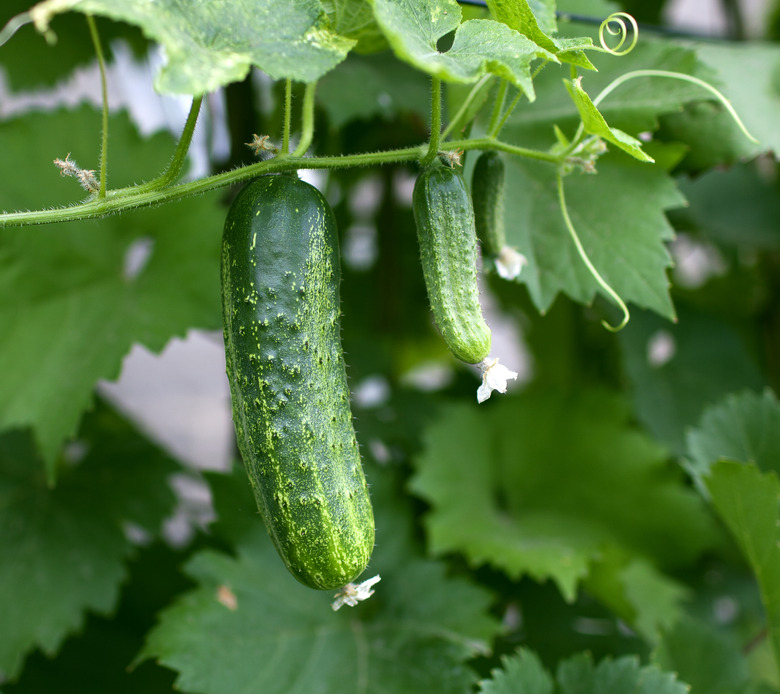How To Grow Cucumbers
We may receive a commission on purchases made from links.
Whether you're looking for big vegetables you can slice into a salad or smaller individuals for pickling, there's a cucumber (Cucumis sativus) for you. Best suited for large gardens, vining cucumber plants produce more cucumbers. If you're planting in containers or a small space, however, a bush cucumber variety will work best for you.
Whatever style you plant, you'll need to do so well into the growing season. Cucumbers are tropical plants and will not tolerate cold temperatures. Once they're up and running, however, cucumbers grow quickly and require very little attention.
If you've selected a vining cucumber variety, consider training it onto a trellis or cage as it grows. This saves space and keeps the growing cucumbers off the ground, where they will stay clean. Keep your cucumber beds well mulched and free of weeds. If Mother Nature fails to do so, provide your plants with 2 inches of water per week throughout the growing season.
Best Uses for Cucumber
Best Uses for Cucumber
Although they do produce yellow flowers, gardeners grow cucumbers for their fruit and not for decoration. Some people prefer slicing cucumbers that go well with summer salads or float in water pitchers to add a bit of flavor. Slicing cucumber varieties grow to about 6 or 8 inches long and reach 1 inch in diameter. Some recommended slicing varieties include Burpless Beauty, Slicemaster and Sweet Success.
You can also grow cucumbers for pickling. Pickling cucumbers are shorter at only 3 to 6 inches long but can still reach diameters of 1 inch. Size isn't the only difference between slicing and pickling cucumber varieties, however. Pickling cucumbers have thinner skin so that brines and pickling spices can penetrate them more deeply. If you're looking for a few good pickling cucumbers, consider Calypso and Fancipak.
How to Grow Cucumber
How to Grow Cucumber
- Common Name: Cucumber
- Botanical Name: Cucumis sativus
- When to Plant: Wait until soil temperatures stay 70 degrees Fahrenheit or above
- USDA Zones: Grown as an annual in zones 4-11
- Sun Exposure: Eight to 10 hours of full sun every day
- Soil Type: Well-drained loam
- When it's in Trouble: Leaves turn yellow when nitrogen levels are too low
- When it's Thriving: Plant will grow quickly and vigorously
Starting Cucumber From Seed
If you are growing your cucumber plant from seed, you can start your seeds indoors about three weeks before planting or sow the seeds directly into the garden. Note that cucumbers absolutely will not tolerate frost. Wait to sow your seeds outside until at least two weeks after the last frost.
To plant, begin by working some rich compost into your soil. You'll then dig a trench 1 inch deep into your soil. Every 12 to 14 inches, drop three or four seeds into the trench and cover them with about an inch of soil. Water your seeds deeply but gently so you don't dislodge them or wash them away.
If necessary, thin your cucumber plants seedlings when they reach 4 inches tall, leaving one plant every 12 to 24 inches depending on the variety.
Starting Cucumber From a Seedling
Because it's so easy, many gardeners grow cucumbers from seeds. You can, however, purchase seedlings if you prefer. Like seeds, young plants will benefit from a bit of compost worked into the soil before planting and need to be watered after.
When planting seedlings, space them 2 feet apart and leave 4 feet of space between planting rows. If you are planning to trellis your cucumbers, you can plant them closer together, leaving 1 foot of space between plants instead of 2 feet. Cucumbers have a long taproot, so make sure you dig your planting holes deep enough to accommodate them. The remaining roots tend to stay shallow and need to be covered by about an inch of soil after planting.
In What Zone Does Cucumber Grow Best?
In What Zone Does Cucumber Grow Best?
If you love homegrown cucumbers, you'll be happy to hear that you can grow them as annuals in USDA zones 4 through 11. Cucumbers will grow anywhere in the United States except perhaps parts of Alaska. As long as the nighttime soil temperature reaches 70 degrees Fahrenheit or more, your cucumbers will grow.
When Should You Plant Cucumber?
When Should You Plant Cucumber?
Plant your cucumber two weeks after the last frost in your area. The soil should stay at least 70 degrees at night when you plant, even if the air temperature goes lower. Depending on the variety, you can expect cucumbers anywhere from 50 to 70 days after planting. Use this information to plan your plantings.
To create a longer harvest season, some gardeners plant multiple varieties of cucumbers all at once so they have fruit both early and late in the season. Others plant the same varieties, planting one set of plants early in the season and then another set midseason to achieve the same long harvesting effect.
It takes only one frost to kill a cucumber plant, however, so make sure you plant well after winter's last frost and harvest your cucumbers before fall's first freeze.
Soil, Sunlight and Water Recommendations for Cucumber
Soil, Sunlight and Water Recommendations for Cucumber
Cucumber plants need full sun and do best when they get eight to 10 hours of sunlight per day. They also prefer sandy or loamy soil, but any soil that drains well will do. If your soil drains poorly, consider amending it or planting your cucumbers on small mounds to help excess water run off. Cucumbers need 2 inches of water per week.
Most gardeners agree that cucumbers are heavy feeders that benefit from fertilizer. Different growers recommend different fertilizers, however. Some recommend side-dressing the plants with a 21-0-0 nitrogen fertilizer after the cucumber vine develops runners but before it flowers. Use 1/4 cup of fertilizer per 10 feet. Others recommend a more balanced 10-10-10 or 10-20-10 blend. If you're not sure which to choose, you can experiment a bit and see what works best in your garden. But to take the guesswork out of the equation, apply fertilizer based on the results of a soil test.
If possible, use drip irrigation to water your cucumbers. If you are watering by hand, direct the water at the base of the plants. Avoid wet leaves whenever possible, as they can encourage the growth of mildew.
How to Propagate Cucumber
How to Propagate Cucumber
Cucumber seeds are readily available at garden centers in the spring, but you can grow plants from your own seeds if desired and if you're growing heirloom plants. Seeds produced by hybrid plants may not germinate; if they do, the plants may not bear fruits true to the parent plants. To do so, leave a few cucumbers on the vine instead of harvesting them. Let the cucumbers turn yellow or orange and then wait a few more days before collecting them.
After harvesting your overly ripe cucumber, cut it in half lengthwise and use a spoon to scoop out the seeds and their surrounding pulp. Place the pulpy seeds in an open jar or bucket of water for about three days. This ferments the seeds and removes the pulp from them.
After fermenting, add more water to your seeds and stir them. As you do, the pulp will rise to the top, and you can pour it off. Retrieve the clean seeds from the bottom of your container, discarding any that float to the top. Rinse them and spread them on an old screen to dry. They're ready to sow when you can snap them cleanly in half.
How to Harvest Cucumber
How to Harvest Cucumber
In about 50 to 70 days, depending on the cultivar, your cucumbers will be ready for harvest. Pick them when they're firm and green. Cucumbers left on the vine too long taste bitter, so stay vigilant at harvest time. To harvest, cut the cucumber off the plant above the fruit rather than pulling or yanking.
Common Pests and Other Problems for Cucumber
Common Pests and Other Problems for Cucumber
Squash bugs often lay eggs and nibble on young cucumber vines. These insects look very much like stink bugs but are narrower and a bit more oblong in shape. Diligently look for these bugs and their orangish egg clusters on your leaves, as catching the problem early is critical. You can deposit both the insects and the eggs into a jar of soapy water to kill them.
As their name implies, you'll also need to look for cucumber beetles on your plants. Striped cucumber beetles feature yellow and black stripes on their backs, while spotted beetles have yellow backs dotted with black spots. You can remove these beetles by hand if desired. This is best accomplished when wearing gloves that have some gripping texture and that you've dipped in petroleum jelly.
You may need to use an insecticide for both squash bugs and cucumber beetles. If so, it's best to contact your local state extension office for guidance. The staff there can tell you which pesticides work best on cucumbers, which can be sensitive to certain chemicals. Extension offices also know which pesticides are safe to use on food crops.
Aphids also like to munch on tender cucumber leaves. Usually, a shot of water from the garden hose will knock aphids off your plants easily. There's generally no need to apply chemicals for aphids.
Common Diseases for Cucumber
Common Diseases for Cucumber
Cucumber plants have a reputation for developing powdery mildew. Caused by a fungus, this disease causes white spots on both the tops and bottoms of cucumber plant leaves. To prevent it, leave adequate space around your plants for air circulation and try to avoid wetting the leaves of your plants when watering. Rotating your crops and planting cucumbers in different places each year also reduce the risk of powdery mildew.
If your plants already have powdery mildew, assess the size of the issue. If only a few leaves or plants are affected, remove them and dispose of them with your garbage rather than composting them. A more extensive problem may require chemical treatment.
In that case, visit your garden center for a sulfur-based fungicide and apply it as directed. Sulfur fungicide is available as a dust, powder or liquid, so you can choose the application method with which you feel most comfortable.
References
- Texas A&M AgriLife Extension: Cucumbers
- Bonnie Plants: Growing Cucumbers
- The Old Farmer's Almanac: Growing Cucumbers
- The Old Farmer's Almanac: Squash Bugs
- The Old Farmer's Almanac: Cucumber Beetles
- Seed Savers Exchange: Grow and Save Cucumber Seeds
- Purdue University Extension: Using Organic Fungicides



